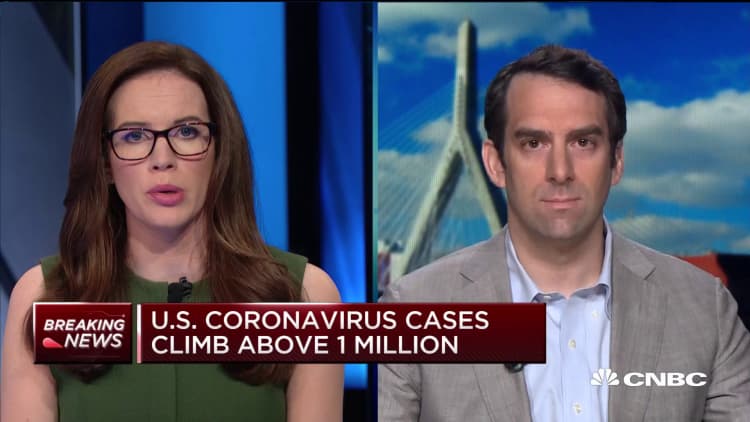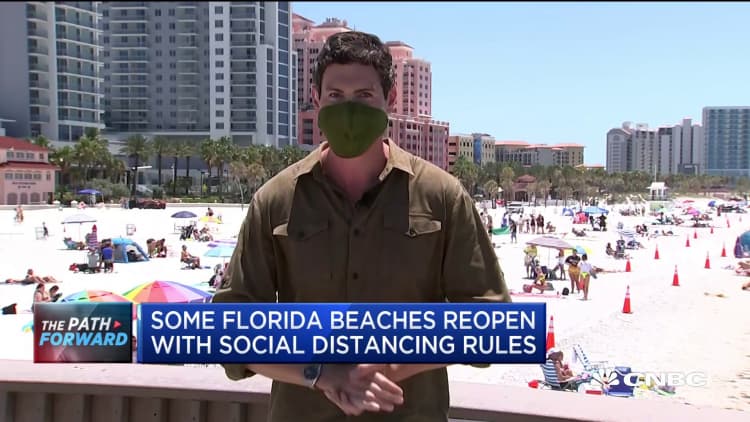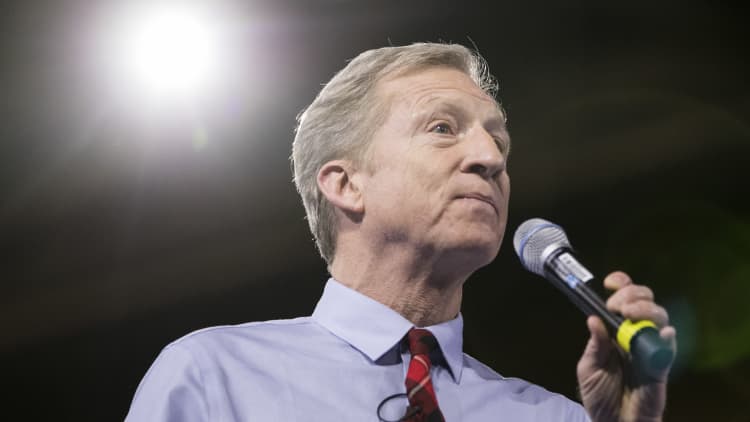Never before has the U.S. fallen into a recession led by the services sector, so there is no real road map for the recovery.
That's why economists are looking for new ways to measure a rebound from a deep recession.
The recovery, they say, will depend on individual psychology, overall consumer confidence, and also whether the government was successful enough in filling the income gap for the workers who lost their jobs.
The parts of the economy that were hit hardest depend the most on consumers' discretionary spending — for dining, entertainment and travel. When consumers stopped leaving their homes in March, they cut spending and saved more than 13.1% of their income, the most in 45 years.
How much of that saved cash becomes a springboard for a recovery depends on how confident those consumers feel about the economy and their jobs. According to Dow Jones, about 22 million American jobs were lost in April and the unemployment rate could be above 16%, the highest since 1939, when government jobs data is released on Friday.

The end of this recession will depend much more on how consumers react than in past recoveries. "It's much more behavioral. It's not just driven by incomes. It's driven by fear," said Diane Swonk, chief economist at Grant Thornton. Economists have been looking to China as an example, since the disease started there. "Even a month after they reopened in Wuhan, people are still worried about going to public places and malls."
In Georgia, which reopened businesses late last month, there is a hesitancy by consumers, she said. "There's a fear about reopenings and visiting places," she said. "The malls opened to a lot of fanfare, advertised like crazy, but few people showed up."
Reopening rules vary by states, regions and even cities. "The U.S. is in this weird position, where we've done worse than other major countries in taming Covid and bending the curve, except for New York, and we've opened before the others have which means were' going to be living with a higher percentage of risk. Risk is what makes you hesitate," Swonk said.
'Pent up' demand
April data on the health of the services sector is expected to be released Tuesday, when both the ISM nonmanufacturing survey and Markit Services PMI are reported. ISM is exceed to fall to 35.7 from 52.5 in March, according to Dow Jones. A number under 50 signals economic contraction.
Economists say all of their assumptions depend on whether there is a revival of the virus, which could shut down the economy again.
Since states shut down in March, the economy contracted rapidly, shrinking 4.8% in the first quarter, ahead of an anticipated decline of about 30% or more in second quarter gross domestic product. Third quarter growth is expected to turn positive by many economists.
The immediate layoffs in March of service workers amid shut down of restaurants, stores, travel, entertainment and sporting events spread to include manufacturing and other areas. But it is the ability of the services sector to bounce back that may prove more difficult. Economists say it may come back at different speeds, in different shapes and will likely employ fewer workers.
"There's pent up demand, even for haircuts," said Tom Lee, founder of Fundstrat. Le said the part of the economy hit the most by social distancing, like restaurants and sporting events, were responsible for $717 billion annually, and it's about 6% of personal consumption expenditures.

Lee said businesses may come back gradually or in different forms. For instance, more dollars are going to online shopping, and retail may have been transformed permanently and more rapidly than anticipated. The internet's market share of sales may have permanently jumped as a percent of retail spending. A high-profile casualty in that industry, J. Crew, filed for bankruptcy Monday.
The airline industry may not come back as it once was, since higher-end business travelers may at least initially be traveling far less. Lee said he views airline travel as largely discretionary, and a key part of business travel is to visit clients. While he expects more of that to be done in video conferencing, he does expect air travel to pick up again. But the industry could be changed, and a downsized airline industry could have different fare structures.
"The U.S. is a service economy so the resilience of the service economy is really central to the economic recovery and stock market recovery. You can't have an equity recovery if the service economy is not resilient. The key will probably be how much the service economy will be hurt by the need for physical distances once we reopen the economy, how much pent up demand there is." Lee said.
Lee said it also has become clear that many industries are going to review whether they really need so many workers in the office when it seems that some have been just as productive working at home. "A lot of people are going to reengineer their workload," he said. "I think there's potentially going to be all this empty real estate that has to be rethought."
Consumers, who make up about 67% of the economy, also pulled back sharply on health care in March, cutting spending on dentists, doctors and elective surgery. Health care spending declined 18% on an annualized basis for the first quarter, according to Commerce Department data.
Telemedicine may be a trend that is also expected to become a bigger part of patient treatment after growing during the shutdowns.
"The biggest surprise was that health care [spending] was down so much," said Stephen Stanley, chief economist at Amherst Pierpont. "In some ways, that's a little bit encouraging that it will come back more quickly, people will go to the doctor and go more readily in June and July. That's starting in states. Non-essential surgery is going to come back, but more slowly."
Developing new expertise
Stanley, who follows statistics on the spread of the virus very carefully, acknowledged that economists have had to build new expertise to track a health impact on the economy. Economists have been tracking the number of new infections, hospitalizations and pharmaceutical developments. They are also tracking how the virus is progressing in different states, as more than half of U.S. are in the process of reopening parts of their economy.
"If you look at the models, the casualty numbers go down pretty sharply in the next four weeks. I think the psychology is going to change a little bit. It's very different when you're seeing 1,000 deaths a day rather than 20 deaths a day," Stanley said. "Everybody's trying to learn about something they knew nothing about a few months ago."

Some businesses have adjusted to the shutdowns and social distancing, including many restaurants that are keeping their doors open with takeout orders, though with less staff and profits. 'We're seeing anecdotally even now people are starting to order out a little more, getting less worried about the virus in their food," Stanley said. "It will be a gradual recovery. In some states they're talking about 25% of restaurants can open. It's not going to be back to the February level for restaurants any time soon."
Stanley said consumer psychology will depend on whether the virus recurs.
"Everybody's got a different risk tolerance. There are people who will go and do things as soon as they're allowed and there are people who are going to sit at home a month or two longer," said Stanley.
Stanley said one big factor will be how confident people are about their jobs, and whether, as he expects, the labor market picks up after unemployment peaks in May. He expects millions of workers a month to be rehired and the unemployment to decline from double digits by fall.
He said the the federal programs to put money in the hands of small businesses has been important as are the increased benefits for unemployed workers, to fill the pay gap temporarily.
As for Tuesday's data, Swonk said the nonmanufacturing ISM is not purely services, since it includes the energy sector, hurt both by the loss of demand and the price war between Saudi Arabia and Russia earlier this year. ISM also includes employment and new orders.
"There are a lot of other surveys, like Open Table reservations that we're watching for high frequency data," she said "They give us a sense where the activity has come to a standstill. There's no historic data to compare to the Great Recession."
The service sector never took a hit like this, and consumer spending slumped to 7.5% in March, its lowest since the data was recorded in 1959. Stanley expects it could fall by 9% in April.
"These businesses had always been collateral damage," in other downturns, Swonk said. "Health care has been struggling here with winners and lowers for a while … Now we're realizing the huge fractures in our system and access to health care in rural areas which is diminishing even more. They don't have the financial wherewithal to get through this."



